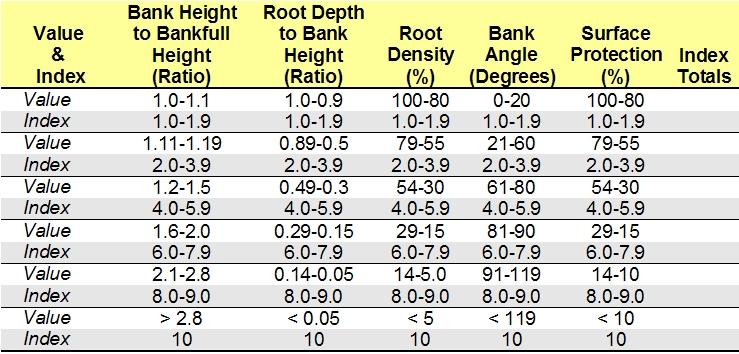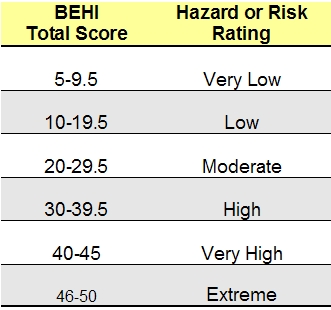
| glossary | menu | Normal | lg | hc | 8.) Rosgen Classification of Stability and Change > Bank Erosion Hazard Index Exercise |
| < Previous | 1 | 2 | 3 | 4 | 5 | 6 | 7 | 8 | 9 | 10 | 11 | 12 | 13 | 14 | 15 | 16 | 17 | 18 | 19 | 20 | 21 | 22 | 23 | Next > |
Bank Erosion Hazard Index Exercise

Exercise Objective
To estimate Rosgen Bank Erosion Hazard Index (BEHI) based on given Stream characteristics.Exercise Process
- Use the BEHI rating sheets to follow the exercise.
- Read the following river assessment for the E4 channel, inventoried for your consideration:
- Bank height to Bankfull height ratio value is 1.6
- Root depth to bank height ratio value is 0.3
- Root density value is 79%
- Bank angle value is 61 degrees
- Surface protection value is 54%.
- Further, the E4 has a cobble bank material with less than 25% gravel and sand to consider
- Find the values for each condition in the BEHI table. Note the range given allows for variability.
- Determine the approximate index number for each value, located below the value number. Again, note the range of numbers given.
- Sum the total numeric index score. You may interpolate index numbers within the range, or select a set or an average value.
- Record each numeric value and sum the values for each of the 5 Stream bank categories (bank height to surface protection).
- Use the provided table to convert the BEHI Total Score into a Hazard or Risk Ranking.

Image modified courtesy of Rosgen
| < Previous | 1 | 2 | 3 | 4 | 5 | 6 | 7 | 8 | 9 | 10 | 11 | 12 | 13 | 14 | 15 | 16 | 17 | 18 | 19 | 20 | 21 | 22 | 23 | Next > |